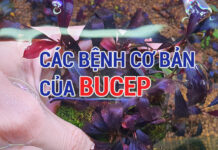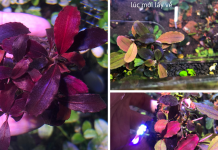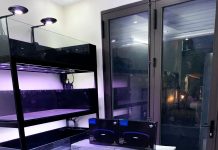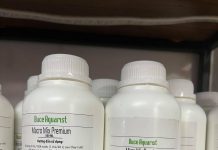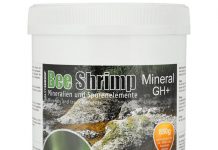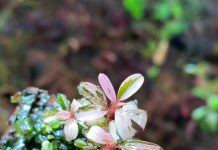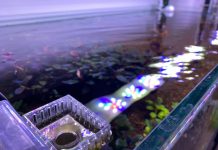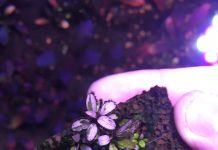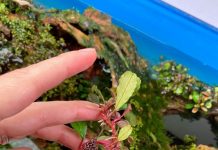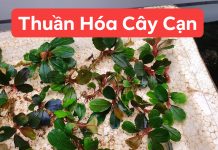Tôi muốn giới thiệu cùng cả nhà bài viết của tôi về một trong những loài cây thuỷ sinh tuyệt vời nhất trong bể thuỷ sinh. Tôi đã chuẩn bị bài này cho một tạp chí Ba Lan, và đã dịch ra tiếng Anh. Tôi muốn cám ơn Philip Rody đã giúp tôi dịch bài viết này.
Tôi mô tả ở đây kinh nghiệm nhiều năm của mình về các loài Bucephalandras, sự phát triển cũng như điều kiện của chúng. Tôi cũng dựa vào những thông tin được tìm thấy trên website và các diễn đàn khác nhau. Nếu có điều gì sai, hoặc các bạn cho rằng chưa hoàn thiện, xin vui lòng liên hệ với tôi qua [email protected].
Dựa trên hình dạng của chúng, Bucephalandras rất giống với Anubias (Ráy) và Cryotocoryne (Tiêu Thảo). Khi lần đầu tiên chúng được giới thiệu với những người yêu thích thuỷ sinh, nó đã được so sánh với Tiêu Thảo Cryptocoryne bởi những chiếc lá hẹp nhiều màu dạng ô lưu. Tuy nhiên, các đốt dầy và các rễ có thể cầm được rất phù hợp với đặc điểm của Anubias (Ráy). Bucephalandra là một loài cây tuyệt vời vẫn còn ở dạng tương đối khó tìm và đang thu hút những người chơi thuỷ sinh khắp thế giới bởi vẻ đẹp choáng ngợp của mình.
MÔI TRƯỜNG
Những cây thuộc họ Araceae ở các vùng đất ẩm, như Bucephalandras, đã thích nghi với cuộc sống ở các dòng sông có dòng chảy mạnh. Mặc dù chúng là loài tương đối mới đối với những người chơi thuỷ sinh, chúng lại được khoa học ghi nhận từ năm 1858. Tên của loài Bucephalandra được lấy theo tên của con ngựa đen Alexander Bucephalus. Tất cả các lời Bucephalandras đều có tính đặc hữu, có nghĩa là chúng chỉ tìm thấy ở một vùng bị cô lập nhất định, thường là ở các dạng hòn đảo. Những cây này có thể được tìm thấy ở những hòn đảo lớn nhất ctại Malay Archipelago, được biết đến là Borneo. Cho đến ngày nay, nhiều loài mới của Bucephalandra vẫn tiếp tục được phát hiện và chưa được mô tả ở các sách thực vật.
Bucephalandras được tìm thấy ở các dòng sông và suối, và đôi khi ở các bờ sông. Borneo có khí hậu nhiệt đới, có nghĩa là nó có nhiệt độ quoanh năm giống nhau với nhiệt độ trung bình vượt 20 độ C. Mặc dù ở một số vùng của đảo có nhiệt độ ổn định, Borneo vẫn có hai mùa dựa trên lượng mưa. Trong suốt mùa mưa khi mực nước sông lên cao, các cây Bucephalandra mọc trên mặt nước bị chìm dưới nước vài tháng. Tuy nhiên, điều này không ngăn được chúng tiếp tục phát triển và chúng có thể dễ dàng chuyển sang dạng lá nước (submerged forms). Những khác biệt lớn nhất giữa lá cạn và lá nước là khi chúng mọc đưới nước, chúng có cấu trúc lá tinh tế hơn và có xu hướng màu sắc đậm hơn.
ĐIỀU KIỆN PHÁT TRIỂN
Ở trong các bể thuỷ sinh, Bucephalandras có thể mọc trên gỗ, gốc cây và cả quả dừa, nhưng trong nhiều năm quan sát của tôi, tôi có thể nói rằng hệ thống rễ của loài cây này phát triển tốt hơn ở các bề mặt cứng, như là các loại đá khác nhau. Các loại rễ này có khả năng bám chặt vào các bề mặt cứng, cho dù chúng trơn nhẵn. Đôi khi thậm chí phải dùng dao để tách cây ra khỏi bề mặt mà nó đã bám, bởi vì rễ của loài cây này bám rất chặt vào bề mặt.
Có một bằng chứng rằng trong môi trường ức chế với sự thay đổi môi trường (như là thay đổi ánh sáng và hoá chất nước), Bucephalandras có thể mất một số lá. Điều rất khá tương đồng với những gì xảy ra ở các loài Tiêu Thảo – Cryptocoryne (mà mọi người thường cho rằng đó là “Bệnh Tiêu Thảo” – “Cryptocoryne disease“). Ở trong các bể của tôi, những thay đổi đột ngột trong việc châm phân nước hoặc bùng phát rêu hại thường gây đến hậu quả về việc mất lá. Tuy nhiên, quá trình này sẽ diễn ra từ từ và hiếm khi có tình trạng cây bị mất lá một cách nhanh chóng, do đó thường là có các phương pháp để những người chơi cấp cứu trước khi tất cả các lá rụng mất. Kể cả không có lá, nếu đốt và rễ cứng cáp và khoẻ mạnh, cây vẫn tiếp tục sống và thường là sẽ phục hồi qua thời gian. Theo kinh nghiệm của tôi, tôi đã tìm thấy tắt đèn và tăng lượng Oxy (O2) vào nước, trong suốt khoảng thời gian tắt đèn này, sẽ giúp cây hồi phục nhanh chóng.
Cho dù chỉ có một lương ánh sáng tối thiểu, Bucephalandras vẫn có thể tiếp tục sống và mọc lá mới, nhưng màu của cây sẽ thường là không được bắt mắt.
Để đảm bảo có màu sắc tốt, ánh sáng mạnh hơn được yêu cầu (0.5W trên mỗi lít hoặc hơn), và việc bổ sung phân qua dòng nước là rất có lợi. Cho dù chỉ có một lượng CO2 rất nhỏ và phân nước rất ít cũng có thể giúp cây phô diễn màu sắc cuốn hút. Trong bể thuỷ sinh của tôi, tôi đã sử dụng phương pháp châm phân Extimative Index, phương pháp đã cho phép cây nhận được một lượng phân lớn trong dòng nước để hấp thụ. Tôi đã nhận ra rằng một số loại phân nhất định có thể giúp tăng màu sắc của lá. Hơn nữa, bằng việc trao đổi cây của tôi với rất nhiều người chơi thuỷ sinh có bể “nông dân” (low-tech), tôi đã được thông báo rằng các lá mới của cây phát triển trong bể của họ không có màu đẹp bởi vì ít ánh sáng hơn và không có nhiều phân cho cây hấp thu.
Quá trình chuyển hoá màu sắc ở Bucephalandra ‘Brownie Brown’:
Các lá màu xanh tương đối phổ biến trong điều kiện mọc cạn (trên đất). Các lá xanh gần gốc của ngọn sẽ vẫn sẽ xanh khi mọc trên mặt nước, trong khi các lá có màu đậm hơn ở phí đầu là kết quả của việc được trồng trong bể thuỷ sinh của tôi:
Qua thời gian, các lá tiếp tục sẽ đậm lại
Cuối cùng, chúng sẽ chuyển sang một màu xanh dương đậm
Hãy xem bức ảnh Bucephalandra ‘Saiyan-1 Black’ khi mọc dưới nước để cảm nhận.
Bucephalandras có thể mọc ở trong các bể bán cạn (paludariums), nhưng màu sắc của lá có xu hướng là yếu hơn, và các lá cũng có xu hướng ít mềm mại (đàn hồi) hơn. Chúng phải được cung cấp độ ẩm cao để tồn tại trong môi trường kiểu này, nếu không các lá sẽ bị khô. Các chỉ số nước của Bucephalandras nên theo chỉ dẫn này: pH từ 5 – 8, hầu hết các độ cứng GH và KH, và nhiệt độ nằm ở khoảng 22 – 28 độ C. Ở thời điểm đầu của cuộc phiêu lưu Bucephalandras, tôi đã nghe đồn rằng chúng không thể chịu được nhiệt độ cao hơn 28 độ C bởi vì các lá của chúng sẽ bị rữa ra. Tuy nhiên, tôi chưa từng thấy việc đó xảy ra với cây của tôi, đặc biệt khi nhiệt độ nước lên đến 32 độ C và tôi cũng không nhận thấy bất cứ hiệu ứng tiêu cực nào.
Cũng nên lưu ý sự thật rằng Bucephalandras là một loại Rheotype (loại cây ưa thích dòng chảy xiết), chúng ta cũng cần cung cấp môi trường tương tự trong bể thuỷ sinh để có thể đạt được những kết quả tốt nhất với loài cây này. Những dòng chảy này có thể tạo ra bằng máy lọc trong, hoặc các các có thể được di chuyển đến gần đầu ra của lọc. Các lá của Bucephalandra rất linh hoạt bởi vì môi trường đậm chất aquatic nơi chúng được tìm thấy.
Đối với Bucephanlandras, tôi đã nhận ra rằng tốc độ phát triển phụ thuộc vào chủng loại. Một số loài có thể mọc ra 2 lá mỗi tuần nhưng đó là trong môi trường tối ưu, trong khi những loài khác chỉ có thể mọc được duy nhất 1 lá mỗi 2 tuần. Thông thường thì nó được cho là một loài cây mọc chậm, nhưng nếu bạn cung cấp ánh sáng mạnh, phân nước và CO2 dồi dào, bạn có thể sẽ đạt được tốc độ phát triển nhanh nhất.
Dòng chảy bắt đầu chủ yếu là dưới nước. Rất khó để nói yếu tố nào tạo ra việc cây mọc hoa. Hoa của họ Ráy Anubias thường được sinh ra trong môi trường bị xấu đi như là một cách để tồn tại của loài cây này. Tuy nhiên, Bucephalandras có thể ra hoa khi chúng đạt đến một lượng dinh dưỡng phong phú, và khi chúng ở trong môi trường lý tưởng. Chúng thậm chí có thể mọc nhiều hơn một bông hoa cùng một thời điểm
Bởi vì Bucephlandras mọc khá chậm, GSA (Green Spot Algae) rêu chấm xanh là loại thường gặp, loại có thể hạn chế cây nhận ánh sáng và làm chậm tốc độ phát triển của cây. Tuy nhiên, loài cây này khá khoẻ mạnh và hầu hết các loại rêu đều có thể được xử lý bằng cách tắm cây Bucep từ 10 – 20 phút theo phương pháp Axit citric C6H8O7 – Cictric Acid (một thìa Citric Acid pha với 1.5 cốc nước). Hỗn hợp này quá yếu để làm tổn hại Bucephalandras, nhưng lại đủ mạnh để diệt rêu.
TÊN:
Hiện nay, chỉ có ba loại được mô tả ở sách cây thuỷ sinh: Bucephalandra gigantea, Bucepholandra magnifolia và Bucepholandra motoleyana. Tuy nhiên, một loại có thể có đến hơn 200 biến thể trong tên thương mại, và rất nhiều trong số chúng là loại mới chưa từng được mô tả. Bởi vì rất nhiều cái tên chưa được biết đến trong khoa học, tên thương mại có thể được tạo ra bởi vì tên của vùng miền, sông hoặc bang nơi chúng được thu hoặc (e.g. Kedagang, Kualakuayan, Tapah, Sabah, Kalimantan, Singtang). Các cái tên cũng được tạo nên theo màu và hình dáng của lá (ví dụ Brownie Brown, Reg Gaia, Super Blue). Một ví dụ thú vị của cái tên này là Brownie Ghost, khi chỉ xuất hiện duy nhất một lần ở một vùng nhất định rồi sau đó biến mất.
HÌNH DÁNG:
Điều khiến Bucephalandras trở nên thú vị đến như vậy là hình dáng lá đầy hấp dẫn. Có rất nhiều loại hình dáng lá rất tương đồng với lá của cherry và lá táo. Các loại lá có thể có hình ô van với cạnh phẳng, hoặc ô van với riềm xoăn, dài và thẳng, dài và nhăn, hoặc hình hạnh nhân hoặc giống một giọt nước.
Màu sắc của các ngọn thường là hồng hoặc đỏ, nhưng các lá có thể có có nhiều màu. Tuỳ thuộc vào loài, một số lá có thể có gần hết màu của cầu vồng. Có rất nhiều loại có mọc các “bóng màu xanh” ở trên lá. Đặc điểm này vô cùng thú vị bởi gloss (bóng) chỉ có thể nhìn được khi bạn nhìn ở các góc nhất định. Ở một số loài, chúng ta có thể nhìn thấy những màu khá gióng bóng màu xanh, hoặc màu ánh đồng hoặc màu hues đỏ. Có rất ít loài chỉ có màu xanh thuần tuý (ví dụ Shine Green, Treasure, 2011), và loại hấp dẫn nhất là những loài có lá màu xanh navy sẫm (ví dụ Brownie Brown, Kedagang, Black Centipede, Black Leaf, Central Kali).
Bucephalandras thường là các cây nhỏ. Rất nhiều trong số chúng chỉ mọc cao từ 3 – 5cm. Nhưng chúng cũng có thể mọc lớn hơn (8-15 cm) và thậm chí có loại lớn hơn có thể mọc cao đến 25cm đã được tìm thấy.
Điểm đặc biệt và dễ nhận biết nhất ở tất cả các loài Bucephalandra là những chấm sáng ở trên lá, thường bị nhầm lẫn bởi rất nhiều người chơi thuỷ sinh là những hạt không khí được tạo ra bởi quá trình quang hợp. Dựa vào chủng loại, sự sắp xếp của các chấm này có thể thưa hoặc dày. Những chấm giống thế này có thể nhìn thấy ở họ Ráy Anubias, nhưng chúng thường không dễ nhìn thấy giống ở trường hợp này. Ở dạng lá cạn, Bucephalandra có những chấm khó nhìn hơn, với sự đậm dần lên khi cây hạ thuỷ và chuyển sang lá nước.
Thật không may, các loại Bucephalandras đang dần dần biến mất khỏi môi trường, phần lớn là do sự khai thác và phá rừng trên đảo Borneo. Rất nhiều loài trở nên đặc biệt khó tìm, và một số loại chỉ còn ở bể thuỷ sinh. Mặc dù đây là một tin rất đáng buồn, nhưng bạn cũng sẽ cảm thấy dễ chịu hơn khi biết rằng việc sưu tầm và nuôi dưỡng các loài cây này có thể tác động đến sự tồn tại lâu dài của loài này khi rất nhiều khu vực của Borneo đang đối diện với việc tàn phá rừng ở quy mô lớn. Chúng ta chỉ có thể hy vọng trong tương lai, Borno sẽ đối diện với ít nguy cơ môi trường hơn và có thể phần nào giúp được việc bảo vệ loài cây tuyệt đẹp này.
Unfortunately, Bucephalandras are slowly disappearing from the environment, mainly due to exploitation and deforestation on the island of Borneo. Many varieties are becoming harder to find, and some now only exist in captivity. While this is sad news, it is also comforting to know that the collecting of these plants can be beneficial to their long-term survival as many parts of Borneo are facing wide-scale deforestation. We can only hope that in the future, Borneo will face fewer environmental threats which in turn will help protect these beautiful plants.
Some Of Bucephalandras By Vasteg
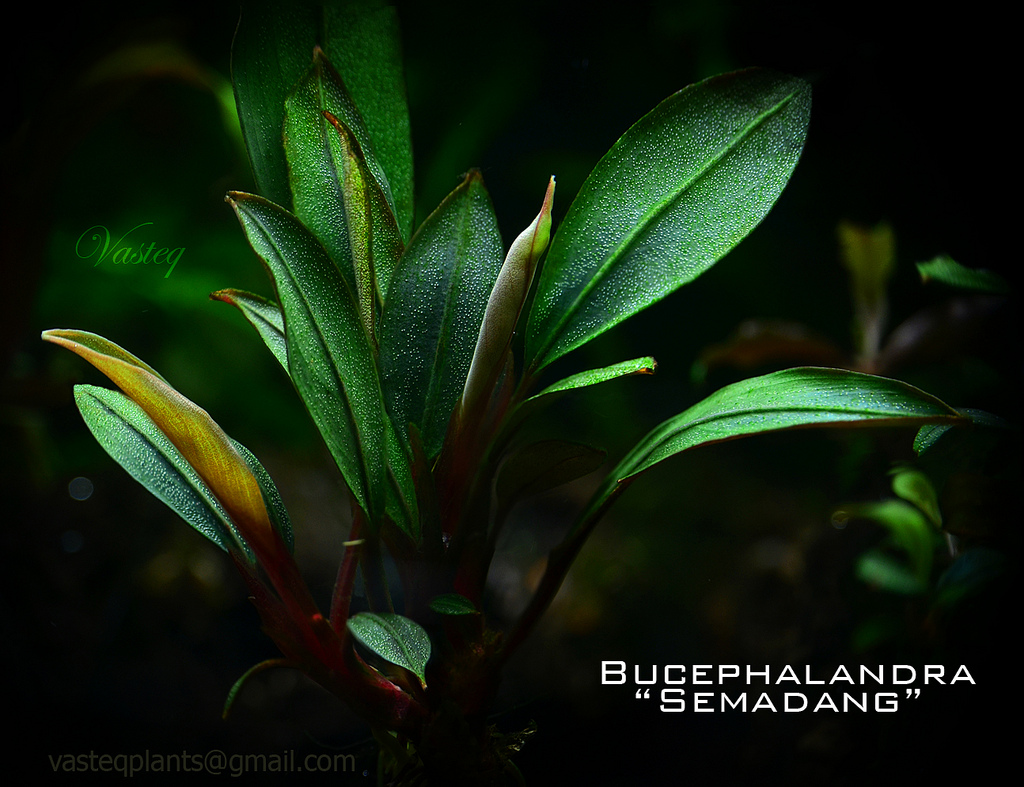
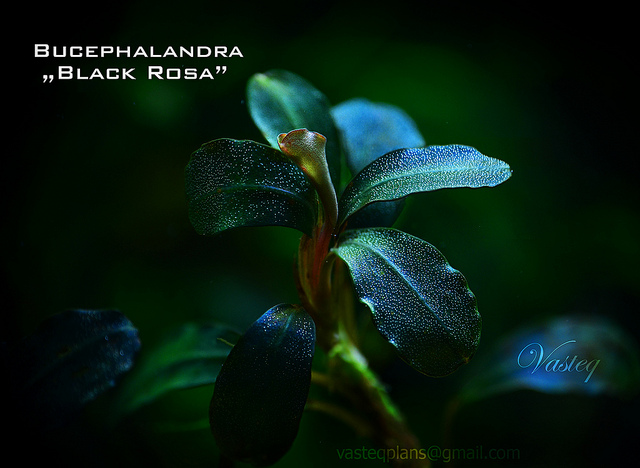
I would like to present my article about one of the most magnificent plants found in aquariums. Article was prepared by me for one of polish magazine, and translated to english. I would also like to thank Philip Rody for help in translating the article.
I described here my several years of experiences about Bucephalandras species, their growth and conditions. I was also basing at the information found on the websites and other forums. If any of them are wrong, or considered to be incomplete, please write and comment my article or contact me at [email protected]
Based on their appearance, Bucephalandras are similar to Anubias and Cryptocoryne species. When they were first introduced to the aquarium hobby, they were compared to Cryptocoryne species because of their narrow and usually olive-colored leaves. However, their creeping rhizomes and prehensile roots fit the characteristics of Anubias more closely. Bucephalandra is a wonderful and still relatively hard-to-find genus of plants that captivate many aquarists across the world thanks to their majestic appearance.
ENVIRONMENT
Wetland plants from the Araceae family, such as Bucephalandras, are adapted to life in rivers with fast-moving currents. Although they are a relatively new genus of plants to aquarists, they have been known to the scientific world since 1858. The genus name Bucephalandra refers to the name of the black horse of Alexander—Bucephalus. All Bucephalandras are endemic, which means that they can only be found in certain isolated areas, usually in the form of islands. These plants can be found on the largest island of the Malay Archipelago, known as Borneo. To this day, new varieties of Bucephalandra are continuously being discovered that have not been yet describe in botany textbooks.
Bucephalandras are found in rivers and streams, and sometimes on the banks of rivers. Borneo has a tropical climate, which means that there is the same climate year-round with average annual temperatures exceeding 20 degrees Celsius. Despite the consistent climate in some areas on the island, Borneo still has two seasons that are determined by the amount of rainfall. During the rainy season when the river level rises, Bucephalandra plants growing out of water are submerged under water for a few months. However, this does not prevent them from continuing to grow and they can easily transform into their submerged forms. The main differences between submersed and emersed forms are that when they are grown under water, they have a more delicate leaf structure and they exhibit more intense coloration.
GROWING CONDITIONS
In aquariums, Bucephalandras can be grown on wood, roots of trees, and coconuts, but from my several years of observation I can say that the root systems of these plants are better developed on hard surfaces, such as various types of rocks. The roots have the ability to firmly attach to hard surfaces, even if they are slippery. Sometimes it is even necessary to use a knife to remove the plant from the surface that it is attached to, because the roots of the plant have grasped the surface so tightly.
There is evidence that in times of stress associated with environmental changes (such as changes in light and water chemistry), Bucephalandras may lose some of their leaves. This similarly happens in Cryptocoryne species (which is often referred to as “Cryptocoryne disease”). In my tanks, the sudden changes in fertilization or an algae plague are usually responsible for the loss of leaves. However, this process is gradual and there is rarely a situation in which the plant looses all of its leaves quickly, so it is often possible for the aquarist to treat the problem before all of the leaves have fallen. Even without leaves, if the rhizome and roots are firm and healthy, the plant is still alive and will usually recover over time. From my experience, I have found that completely dimming the light and increasing the amount of dissolved oxygen in the water, at the time of the darkness, can help the plant recover quickly.
Even with only minimal amounts of light, Bucephalandras will continue to grow and will still produce new leaves, but the color of the plant is usually not as eye-catching.
To ensure good coloration, stronger lighting is required (0.5W per litter or more), and additional fertilizing through the water column is beneficial. Even small amounts of CO2 and fertilizer can help the plant display attractive colors. In my aquarium, I follow the Estimative Index fertilization method, which allows the plants to have a large amount of fertilizers in the water column to utilize. I have noticed that certain fertilizers can help improve the color of the leaves. Additionally, through my exchanging of plants with many aquarists who have “low-tech” aquariums, I was informed that the new leaves of the plants grown in their tanks are not as colorful because there is less light and not as many fertilizers for the plants to use.
The evolution of color in Bucephalandra ‘Brownie Brown’:
Green leaves are prevalent when grown in emersed conditions (on land). The green leaves near the bottom of the stem still remain from when the plant was grown out of water, while the new darker leaves near the tip are a result of having been grown under water in my aquarium:
Bucephalandras can also be grown in paludariums, but the coloration of the leaves tends to be weaker, and the leaves tend to be less elastic as well. They must be provided with high humidity in order to thrive in such environments, otherwise the leaves can dry out. The parameters of water that Bucephalandras can tolerate are as follows: pH range of 5-8, almost any GH and KH, and a temperature between 22-28 degrees Celsius. At the beginning of my adventure with Bucephalandras, I heard that they cannot tolerate temperatures higher than 28 degrees Celsius because it could cause the leaves to melt. However, I have yet to see this happen with my plants, especially when the water temperature rose to 32 degrees Celsius and I did not notice any negative side effects.
It should be noted that due to the fact that Bucephalandras are a type of rheotype (plants that like swift-flowing currents), we need to provide similar conditions in our aquariums in order to achieve the best results with these plants. Such currents can be achieved by using an internal filter, or the plants can be moved near a filter outlet. The leaves of Bucephalandra are flexible because of the aquatic environment in which they are found.
For Bucephalandras, I have found that the growth rate is dependent on the variety. Some varieties can produce 2 leaves per week if they are in optimal conditions, while others will produce only 1 leaf every 2 weeks. Generally it is said that they are slow-growing plants, but if you provide them with strong light, fertilization, and plenty of CO2, you will achieve the fastest growth possible.
Flowing begins mainly under water. It’s hard to tell what factors cause the plant to produce a flower. Flowering of Anubias species is often accompanied by deteriorating environmental conditions and is regarded as a form of survival for the plant. However, Bucephalandras can flower when they have access to an ample supply of nutrients, and are in ideal conditions. They can even produce more than one flower at a time (photo below).
Because Bucephalandras grow so slowly, green spot algae is a common problem, which may limit access to light and also slow down the growth rate of the plant. However, they are quite hardy and most algae types can be removed by using a 10-20 minute bath in a solution of citric acid (one teaspoon of citric acid to 1.5 cups of water). This mixture is too weak to damage the leaves of Bucephalandras, but it is strong enough to kill the algae.
NAMING:
Currently, only three species are described in plant textbooks: Bucephalandra gigantea, Bucepholandra magnifolia, Bucepholandra motoleyana. However, one can encounter more than 200 variations of trade names, and many of these may be new species that have yet to be described. Because many species names are currently unknown to science, the trade names are created based on the names of regions, rivers, or states where they were collected (e.g. Kedagang, Kualakuayan, Tapah, Sabah, Kalimantan, Sintang). The names are also created according to the coloration and shape of the leaves (e.g. Brownie Brown, Red Gaia, Super Blue). An interesting example of the names of these plants is Brownie Ghost, which appeared only once in a certain area and then disappeared.
In the aquarium hobby, Bucephalandras appeared as recently as 2005-2006 and immediately became popular. The plants are very expensive, but over time they will become more affordable.
APPEARANCE:
What makes Bucephalandras so interesting is their very appealing leaf shapes. There are a variety of leaf shapes that are similar to the leaves of cherry and apple trees. The leaves may be oval with flat edge, oval with wavy edge, long and straight, long and wavy, or even almond shaped or like a drop of water.
The colors of the stems are mainly pink or red, but the leaves can be multi-colored. Depending on the species, some leaves can have almost all colors of the rainbow. There are many varieties, where there appears to be a “blue gloss” on the leaves. This characteristic is interesting because the gloss is only visible when you look at it at certain angles. In some varieties, we can also see other colors similar to a bright green gloss, or the color of copper or reddish hues. There are relatively few varieties which are typically green (e.g. Shine Green, Treasure, 2011), and the most attractive are the variety of dark navy blue leaves (e.g. Brownie Brown, Kedagang, Black Centipede, Black Leaf, Central Kali).
Bucephalandras are typically a small plant. Many of them only grow up to 3-5 cm. But there are also many that grow larger (8-15 cm) and even larger variations growing up to about 25 cm in height have been found.
Comparative photos of several varieties on hand:
A distinctive and recognizable feature of all Bucephalandra are bright spots on the leaves, mistakenly recognized by many aquarists as air bubbles resulting from the process of photosynthesis. These spots are found in most varieties of Araceae plants. Depending on the variety, the arrangement of dots may be more or less intense. Similar spots can also be seen on Anubias, but they are not as noticeable. On emersed forms of Bucephalandra, the spots are less visible, with their intensity increasing when the plant is submerged.
Unfortunately, Bucephalandras are slowly disappearing from the environment, mainly due to exploitation and deforestation on the island of Borneo. Many varieties are becoming harder to find, and some now only exist in captivity. While this is sad news, it is also comforting to know that the collecting of these plants can be beneficial to their long-term survival as many parts of Borneo are facing wide-scale deforestation. We can only hope that in the future, Borneo will face fewer environmental threats which in turn will help protect these beautiful plants.


